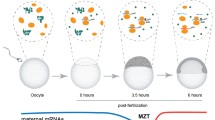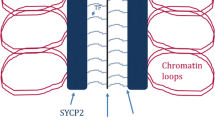Abstract
Background
The homologous genes Spin (spindlin) and Ssty were first identified as genes involved in gametogenesis and seem to occur in multiple copies in vertebrate genomes. The mouse spindlin (Spin) protein was reported to interact with the spindle apparatus during oogenesis and to be a target for cell-cycle-dependent phosphorylation. The transcript of the mouse Ssty gene is specific to sperm cells. In the chicken, spindlin was found to co-localize with SUMO-1 to nuclear dots during interphase in fibroblasts, but to co-localize with chromosomes during mitosis. Thus, Spin/Ssty genes might be important in the transition from sperm cells and oocytes to the early embryo, as well as in mitosis.
Results
Here we report the discovery of a new protein motif of around 50 amino acids in length, the Spin/Ssty repeat, in proteins of the Spin/Ssty (spindlin) family. We found that in one member of this family, the human SPIN gene, each repeat resides in its own exon, supporting our view that Spin/Ssty repeats are independent functional units. On the basis of different secondary-structure prediction methods, we propose a four-stranded β-structure for the Spin/Ssty repeat.
Conclusions
The discovery of the Spin/Ssty repeat might contribute to the further elucidation of the structure and function of spindlin-family proteins. We predict that the tertiary structure of spindlin-like proteins is composed of three modules of Spin/Ssty repeats.


Similar content being viewed by others
References
Oh B, Hwang S, McLaughlin J, Solter D, Knowles BB: Timely translation during the mouse oocyte-to-embryo transition. Development. 2000, 127: 3795-3803.
Schultz RM: Regulation of zygotic gene activation in the mouse. BioEssays. 1993, 15: 531-538.
Telford NA, Watson AJ, Schultz GA: Transition from maternal to embryonic control in early mammalian development: a comparison of several species. Mol Reprod Dev. 1990, 26: 90-100.
Huarte J, Stutz A, O'Connell ML, Gubler P, Belin D, Darrow AL, Strickland S, Vassalli JD: Transient translational silencing by reversible mRNA deadenylation. Cell. 1992, 69: 1021-1030.
Oh B, Hwang SY, Solter D, Knowles BB: Spindlin, a major maternal transcript expressed in the mouse during the transition from oocyte to embryo. Development. 1997, 124: 493-503.
Oh B, Hampl A, Eppig JJ, Solter D, Knowles BB: SPIN, a substrate in the MAP kinase pathway in mouse oocytes. Mol Reprod Dev. 1998, 50: 240-249. 10.1002/(SICI)1098-2795(199806)50:2<240::AID-MRD15>3.0.CO;2-A.
Howlett SK: A set of proteins showing cell cycle dependent modification in the early embryo. Cell. 1986, 45: 387-396.
Frank-Vaillant M, Haccard O, Ozon R, Jessus C: Interplay between Cdc2 kinase and the c-Mos/MAPK pathway between metaphase I and metaphase II in Xenopus oocytes. Dev Biol. 2001, 231: 279-288. 10.1006/dbio.2000.0142.
Bishop CE, Hatat D: Molecular cloning and sequence analysis of a mouse Y chromosome RNA transcript expressed in the testis. Nucleic Acids Res. 1987, 15: 2959-2969.
Burgoyne PS, Mahadevaiah SK, Sutcliffe MJ, Palmer SJ: Fertility in mice requires X-Y pairing and a Y-chromosomal "spermiogenesis" gene mapping to the long arm. Cell. 1992, 71: 391-398.
Conway SJ, Mahadevaiah SK, Darling SM, Capel B, Rattigan AM, Burgoyne PS: Y353/B: a candidate multiple-copy spermiogenesis gene on the mouse Y chromosome. Mamm Genome. 1994, 5: 203-210.
Itoh Y, Hori T, Saitoh H, Mizuno S: Chicken spindlin genes on W and Z chromosomes: transcriptional expression of both genes and dynamic behavior of spindlin in interphase and mitotic cells. Chromosome Res. 2001, 9: 283-299. 10.1023/A:1016694513051.
Laval SH, Reed V, Blair HJ, Boyd Y: The structure of DXF34, a human X-linked sequence family with homology to a transcribed mouse Y-linked repeat. Mamm Genome. 1997, 8: 689-691. 10.1007/s003359900538.
National Center for Biotechnology Information ftp server. [ftp://ncbi.nlm.nih.gov]
ENSEMBL ftp server. [ftp://ftp.ensembl.org]
Altschul SF, Madden TL, Schaffer AA, Zhang J, Zhang Z, Miller W, Lipman DJ: Gapped BLAST and PSI-BLAST: a new generation of protein database search programs. Nucleic Acids Res. 1997, 25: 3389-3402. 10.1093/nar/25.17.3389.
Sonnhammer ELL, Durbin R: A dot-matrix program with dynamic threshold control suited for genomic DNA and protein sequence analysis. Gene. 1995, 167: GC1-GC10. 10.1016/0378-1119(95)00714-8.
Jeanmougin F, Thompson JD, Gouy M, Higgins DG, Gibson TJ: Multiple sequence alignment with CLUSTALX. Trends Biochem Sci. 1998, 23: 403-405. 10.1016/S0968-0004(98)01285-7.
Saitou N, Nei M: The neighbor-joining method: a new method for reconstructing phylogenetic trees. Mol Biol Evol. 1987, 4: 406-425.
Felsenstein J: PHYLIP - Phylogeny Inference Package (Version 3.2). Cladistics. 1989, 5: 164-166.
Eddy SR: Profile hidden Markov models. Bioinformatics. 1998, 14: 755-763. 10.1093/bioinformatics/14.9.755.
Bonfield JK, Smith KF, Staden R: A new DNA sequence assembly program. Nucleic Acids Res. 1995, 23: 4992-4999.
Cuff JA, Clamp ME, Siddiqui AS, Finlay M, Barton GJ: Jpred: A consensus secondary structure prediction server. Bioinformatics. 1998, 14: 892-893. 10.1093/bioinformatics/14.10.892.
King RD, Sternberg MJE: Machine learning approach for the prediction of secondary structure. J Mol Biol. 1990, 216: 441-457.
Cuff JA, Barton GJ: Application of multiple sequence alignment profiles to improve protein secondary structure prediction. Proteins. 2000, 40: 502-511. 10.1002/1097-0134(20000815)40:3<502::AID-PROT170>3.0.CO;2-Q.
Salamov AA, Solovyev VV: Prediction of protein secondary structure by combining nearest-neighbor algorithms and multiple sequence alignments. J Mol Biol. 1995, 247: 11-15. 10.1006/jmbi.1994.0116.
Rost B, Sander C: Combining evolutionary information and neural networks to predict protein secondary structure. Proteins. 1994, 19: 55-72.
Zvelebil MJJM, Barton GJ, Taylor WR, Sternberg MJE: Prediction of protein secondary structure and active sites using the alignment of homologous sequences. J Mol Biol. 1987, 195: 957-961.
Kelley LA, MacCallum RM, Sternberg MJE: Enhanced genome annotation using structural profiles in the program 3D-PSSM. J Mol Biol. 2000, 299: 501-522. 10.1006/jmbi.2000.3741.
Shi J, Blundell TL, Mizuguchi K: FUGUE: sequence-structure homology recognition using environment-specific substitution tables and structure-dependent gap penalties. J Mol Biol. 2001, 310: 243-257. 10.1006/jmbi.2001.4762.
Gough J, Karplus K, Hughey R, Chothia C: Assignment of homology to genome sequences using a library of hidden Markov models that represent all proteins of known structure. J Mol Biol. 2001, 313: 903-919. 10.1006/jmbi.2001.5080.
Karplus K, Barrett C, Hughey R: Hidden Markov models for detecting remote protein homologies. Bioinformatics. 1998, 14: 846-856. 10.1093/bioinformatics/14.10.846.
Author information
Authors and Affiliations
Corresponding author
Rights and permissions
About this article
Cite this article
Staub, E., Mennerich, D. & Rosenthal, A. The Spin/Ssty repeat: a new motif identified in proteins involved in vertebrate development from gamete to embryo. Genome Biol 3, research0003.1 (2001). https://doi.org/10.1186/gb-2001-3-1-research0003
Received:
Revised:
Accepted:
Published:
DOI: https://doi.org/10.1186/gb-2001-3-1-research0003




